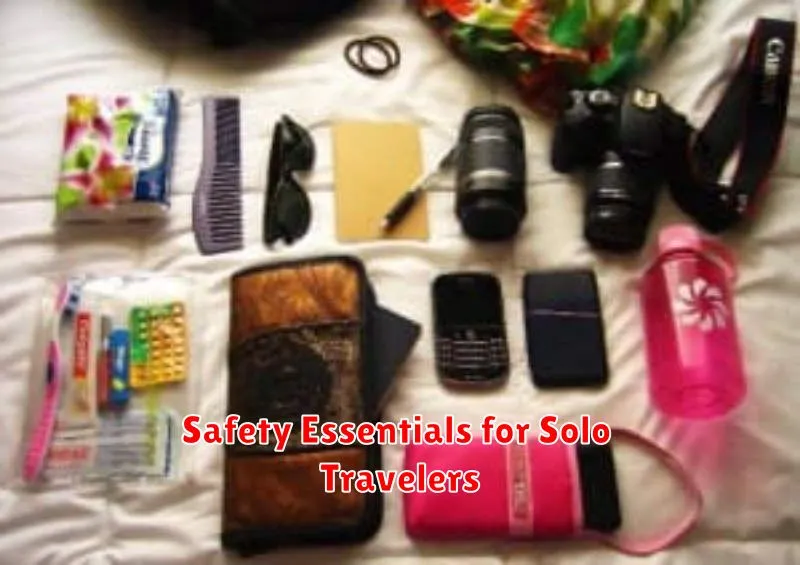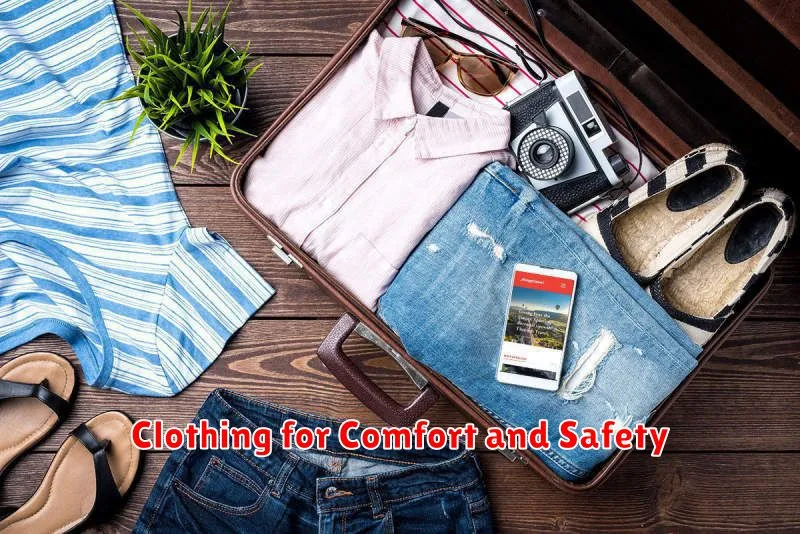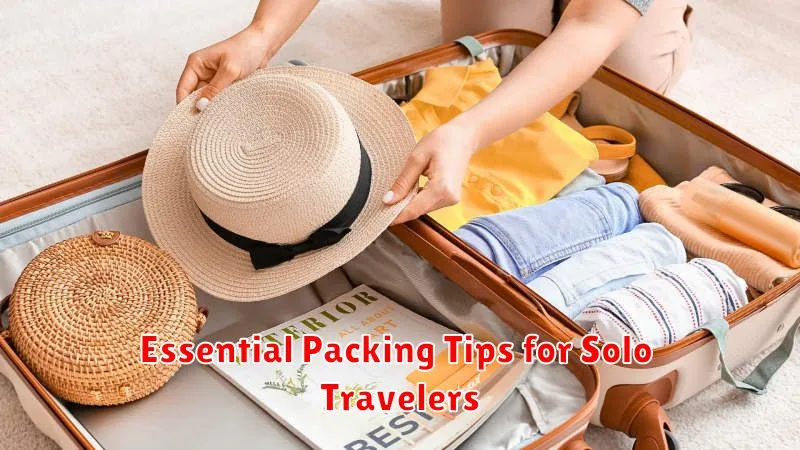Embarking on a solo adventure is an incredibly rewarding experience. Whether you’re planning a weekend getaway or a long-term backpacking trip, careful planning and efficient packing are crucial for a smooth and enjoyable journey. This guide provides essential packing tips for solo travelers, designed to help you maximize space, minimize stress, and ensure you’re prepared for anything your journey may bring. From choosing the right luggage to selecting versatile clothing items and packing essential travel documents, these tips will empower you to travel light and smart.
Traveling solo offers unparalleled freedom and flexibility. However, it also means you’re solely responsible for everything you bring. Overpacking can quickly become a burden, limiting your mobility and adding unnecessary stress to your trip. By following these essential packing tips, you’ll learn how to pack strategically, prioritizing essential items and avoiding unnecessary bulk. This allows you to navigate airports, train stations, and city streets with ease, maximizing your enjoyment of your solo travel experience.
Why Packing Light Is Key
Traveling light offers a multitude of advantages. It reduces stress and hassle, allowing for greater mobility and spontaneity. Navigating busy airports, train stations, and city streets becomes significantly easier without the burden of heavy luggage. You’ll spend less time waiting at baggage carousels and more time exploring your destination. Plus, carrying less reduces the risk of lost or delayed luggage, a common travel headache. Finally, packing light often translates to cost savings, as many airlines now charge hefty fees for checked bags.
Packing light promotes a more mindful travel experience. By carefully considering what you truly need, you’ll avoid bringing unnecessary items that weigh you down, both physically and mentally. This minimalist approach encourages you to focus on the essentials and appreciate the experiences rather than the material possessions. It also fosters a sense of freedom and adaptability, allowing you to embrace unexpected opportunities and changes in plans.
Successfully packing light requires a bit of planning and prioritization. Choose versatile clothing items that can be mixed and matched to create multiple outfits. Pack lightweight, quick-drying fabrics. Utilize travel-sized toiletries and consider leaving bulky items like hair dryers at home (most hotels provide them). By packing strategically, you’ll be amazed at how much you can fit into a small carry-on bag and how much easier and more enjoyable your travels will become.
Packing for Flexibility
Smart packing hinges on anticipating potential needs while minimizing luggage. Choose versatile clothing items that can be mixed and matched to create different outfits for various occasions. Neutral colors are generally preferable as they offer more combination possibilities. Consider the expected weather and activities, but avoid overpacking “just in case” items. Prioritize lightweight, quick-drying fabrics that can be easily layered.
Organize your belongings strategically to maximize space and accessibility. Rolling clothes instead of folding them can save space and minimize wrinkles. Utilize packing cubes or compression bags to compartmentalize items and further compress the contents of your luggage. Keep essential toiletries and a change of clothes readily available in a separate, smaller bag in case of travel delays or lost luggage.
Before zipping up your suitcase, carefully evaluate each item. Ask yourself if you will realistically use it and if it can serve multiple purposes. If in doubt, leave it behind. Remember, packing light allows for greater flexibility and spontaneity during your trip. It reduces stress and allows you to focus on enjoying your experience rather than managing cumbersome baggage.
Safety Essentials for Solo Travelers

Traveling alone can be an incredibly rewarding experience, but it’s crucial to prioritize safety. Before embarking on your solo adventure, research your destination thoroughly. Understand local customs, laws, and potential safety concerns. Identify safe neighborhoods, transportation options, and emergency contact information. Share your itinerary with a trusted friend or family member and keep them updated regularly on your whereabouts. Staying informed and connected is paramount to a safe and enjoyable solo trip.
While exploring new places, trust your instincts. If a situation feels unsafe, remove yourself immediately. Avoid walking alone at night, especially in poorly lit or unfamiliar areas. Be mindful of your belongings and avoid displaying expensive jewelry or electronics. Consider using a money belt or hidden pouch to secure important documents and cash. When choosing accommodation, opt for reputable establishments with good security measures. Be cautious about sharing personal information with strangers and avoid oversharing your travel plans on social media.
Preparation is key to mitigating risks while traveling solo. Pack a basic first-aid kit and any necessary medications. Learn some basic self-defense techniques and consider carrying a personal safety alarm. Stay aware of your surroundings and avoid distractions like using your phone while walking in unfamiliar areas. Remember, your safety is your responsibility. By taking these precautions, you can minimize potential risks and enjoy a fulfilling and secure solo travel experience.
Clothing for Comfort and Safety

Choosing the right clothing significantly impacts both comfort and safety. Comfortable clothing allows for a full range of motion and helps regulate body temperature, preventing overheating or chilling. Safe clothing considers the environment and potential hazards. For instance, brightly colored and reflective clothing enhances visibility in low-light conditions, while sturdy, protective fabrics shield against cuts, abrasions, or specific workplace dangers.
The appropriate attire varies greatly depending on the activity and environment. When engaging in strenuous activities, moisture-wicking fabrics help keep the body dry and prevent chafing. In cold weather, layering provides insulation and adaptability to changing temperatures. In hazardous environments, specialized clothing such as flame-resistant garments or high-visibility vests become crucial for safety. Consider the specific risks and choose clothing that offers adequate protection.
Proper fit is also essential for both comfort and safety. Clothing that is too loose can become entangled in machinery or create tripping hazards. Clothing that is too tight restricts movement and can lead to discomfort. Always ensure your clothing allows for free movement and does not present any safety risks. Select clothing that aligns with the demands of your environment and activity for optimal comfort and protection.
Documents and Digital Backups
Protecting your important documents and digital files requires a comprehensive backup strategy. This involves regularly copying your data to a separate location, ensuring its safety in case of hardware failure, accidental deletion, or other unforeseen events. Consider the 3-2-1 backup rule: 3 copies of your data, on 2 different media types, with 1 copy stored offsite.
There are various backup methods available, including external hard drives, cloud storage services, and network-attached storage (NAS) devices. Choose a method that suits your needs and budget. Regularly test your backups to ensure they are working correctly and that you can restore your data when needed. Establish a consistent schedule for backing up your files, whether daily, weekly, or monthly, depending on how frequently your data changes.
Key documents to include in your backups are financial records, legal documents, personal identification, medical records, and cherished photos or videos. Organizing your digital files into a clear folder structure will make it easier to locate and restore specific files when necessary. Remember to secure your backups with strong passwords and encryption to protect your sensitive information.
Useful Gadgets and Tools
In today’s fast-paced world, having the right gadgets and tools can significantly improve efficiency and productivity. Essential items for daily life might include a reliable smartphone for communication and organization, a versatile multi-tool for quick fixes, and a portable power bank to ensure devices stay charged on the go. For those working remotely or in office settings, a comfortable ergonomic keyboard and mouse can enhance workflow and reduce strain. Investing in these key tools can contribute to a more seamless and productive experience.
Beyond everyday essentials, specialized tools cater to particular needs and interests. Creative professionals might find a digital drawing tablet indispensable for their work, while fitness enthusiasts could benefit from a smartwatch to track their progress. DIYers and hobbyists might value a high-quality set of screwdrivers or a precision knife. Choosing tools specific to your activities can elevate your performance and enjoyment.
When selecting gadgets and tools, consider factors like durability, functionality, and portability. Reading reviews and comparing features can help you make informed decisions. Ultimately, the most useful tools are those that best address your individual requirements and contribute to a more productive and fulfilling lifestyle.
Organizing Your Backpack or Luggage
Efficient packing maximizes space and minimizes stress. Start by planning what you need. Make a list and check it twice to avoid bringing unnecessary items. Consider the length of your trip and the activities you’ll be doing. Choose versatile clothing items that can be mixed and matched. Rolling clothes instead of folding them often saves space and minimizes wrinkles.
Utilize packing cubes or pouches to compartmentalize your belongings. This keeps items organized and makes finding things easier. Place heavier items at the bottom of your bag or closest to your back if using a backpack. This helps distribute the weight evenly and improves stability. Keep essentials like toiletries, medications, and travel documents easily accessible in a separate compartment.
Protect fragile items by wrapping them in soft clothing. Utilize the space inside shoes for storing small items like socks or chargers. Leave some extra space in your bag for souvenirs or items you may acquire during your trip. Finally, before closing your bag, double-check you have everything you need.

